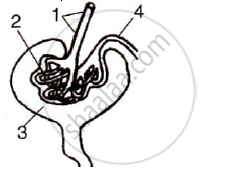Advertisements
Advertisements
प्रश्न
उत्तर
Nephron is the basic structural and functional unit of the kidney.
Its chief function is to regulate the concentration of water and soluble substances like sodium salts by filtering the blood, reabsorbing what is needed and excreting the rest as urine.
APPEARS IN
संबंधित प्रश्न
Bile, Urea, Uric acid, Ammonia
The given diagram represents a nephron and its blood supply. Study the diagram and answer the following questions:

(i) Label parts 1, 2, 3 and 4.
(ii) State the reason for the high hydrostatic pressure in the glomerulus.
(iii) Name the blood vessel which contains the least amount of urea in this diagram.
(iv) Name the two main stages of urine formation.
(v) Name the part of the nephron which lies in the renal medulla.
Draw the well-labelled diagram of the human excretory system
With which human organ system (or human systems) is glomerulus associated?
Differentiate between the following pairs of term :
Renal cortex and renal medulla
Differentiate between the following pairs of term :
Renal pelvis and renal papilla
Study the diagram given alongside and then answer the question that follow:
Name the region in the kidney where the above structure is present?

Explain in your own words with suitable examples.
How is excretion in plants useful to human beings?
Choose the correct option.
Deproteinised plasma is not found in ______.
“All plants give out oxygen during the day and carbon dioxide during the night”. Do you agree with this statement? Give a reason.
